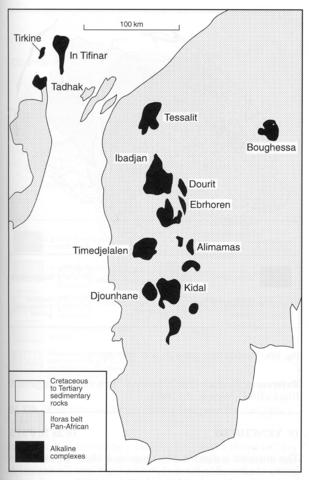stripes
Tessalit is some 30 km in diameter, intruded into rhyolites and consists of four main, overlapping intrusive centres (Ba et al., 1985; Liegeois et al., 1996). Granite is the predominant rock type, with lesser areas of syenogranite and microsyenite, which vary widely in the degree of alkalinity. There is an extensive dyke swarm, cutting particularly the eastern part of the complex. The smallest centre, Wartoradj in the southwest, consists of biotite syenogranites with no peralkaline rocks. The Tin Edemba centre, occupying the central western part of the complex, comprises four units namely biotite and hedenbergite-augite granites, aegirine-arfvedsonite and aegirine granite with sodic and sodic-calcic amphiboles. The Tin Atiwen centre to the east comprises arfvedsonite-riebeckite, aegirine-arfvedsonite-riebeckite, biotite-riebeckite-hornblende and biotite-hornblende granites with an area of biotite-augite-hornblende microsyenite. The Tiraouanine centre, which forms the northern part of the complex, contains two biotite granite units, a biotite-edenite granite and an aenigmatite-aegirine-edenite-riebeckite granite. Modal data for most of these units are given by Liegeois et al. (1996). The extensive trends of pyroxene and amphibole evolution are illustrated by Liegeois et al. (1996) who also give rock analyses for most units.
BA, H., BLACK, R., BENZIANE, B., DIOMBANA, D., HASCOET-FENDER, J., BONIN, B., FABRE, J. and LIÉGEOIS, J.P. 1985. La province des complexes annulaires alcalins sursaturés de l'Adrar des Iforas, Mali. Journal of African Earth Sciences, 3: 123-42.LIEGOIS, J.P., DIOMBANA, D. and BLACK, R. 1996. The Tessalit ring complex (Adrar des Iforas, Malian Tuareg shield): a Pan-African, post-collisional, syn-shear, alkaline granite intrusion. In D. Demaiffe (ed) Petrology and geochemistry of magmatic suites of rocks in the continental and oceanic crusts. 227-44. Universite Libre de Bruxelles, Royal Museum for Central Africa (Tervuren).

